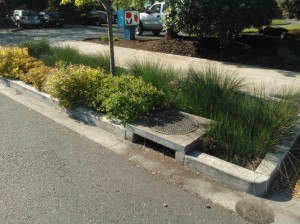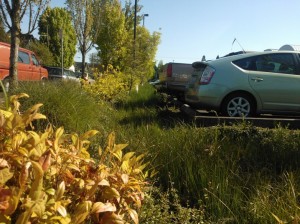Saving North East London’s rivers
These are exciting times for river friendly drainage.
Our project to clean polluted water before it enters the Salmons Brook in Enfield is identifying sites, getting them surveyed, but most importantly involving local people in deciding where they should go.
This green infrastructure may include the creation of wet woodlands, mini wetlands and reed beds. They will filter out oily road run-off, excess nutrients and dirt. The aim is to also cut the number of homes that connect their shower or kitchen waste water pipes to drains that lead straight to a river.
The response from people so far is as you’d hope – that sustainable drainage is a great way to make rivers healthier, and the Salmons Brook needs it.
Sustainable drainage has a greater role to play in Enfield and North East London in terms of protecting rivers in the longer term.

Deephams Sewage Treatment Works in Edmonton takes the waste water from 885,000 homes. This includes the London Borough of Enfield, Eastern half of LB Barnet. Northern part of LB Waltham Forest. Northern half of LB Haringey. Part of LB Redbridge. Western fringe of Epping Forest DC. Southern part of Broxbourne DC. Part of Welwyn Hatfield DC (Cufley).
After heavy rain Deephams fills up with storm water, a mixture of rain and sewage. At present when it reaches its limit it has to discharge this polluted water into the Salmons Brook which joins the Pymmes Brook and then the Lea at Tottenham. Our water quality test results from University College London show faecal e-coli bacteria levels rocket up. Yuck.
Deephams Sewage Works is to have a £300 million upgrade which is great. The plant will be more efficient, using new technologies and have greater capacity. This will see it meet the higher standards required by the Urban Wastewater Treatment Directive. It will mean the water coming out of Deephams is cleaner than ever before. Essential as most of the flow of the Lea comes from the Sewage Works. It’s hoped the work will be finished by 2021.
What Deephams has to contend with is urban growth. Over the last generation 17% of London’s green spaces (like front gardens) have been paved over. Before that each garden was soaking up water, slowing it down. Now it runs off the drive way and into too many sewers and increasing the risk of local flooding. Add to that the car parks, new developments etc and it means more water is getting into our sewers, taking up space that should be for sewage. The loss of these smaller green spaces is getting worse.
The volumes of water entering Deephams Sewage Works when it rains are up to 6 times the flow during dry weather. The upgrade provides us with a unique opportunity. The sewage works upgrade will do a great job in treating the sewage. To extend the life of the new Deephams we need to also start catching the rain that falls in North East London.
We can do more to leave space for sewage by creating sustainable drainage systems in parks, on streets, at blocks of flats. These would hold rain and release it slowly, allowing the new Deephams to treat our waste water – which is what it is for.

Portland, Oregon has done fantastic work reducing sewage pollution to its rivers. Conventional drainage has cut most of the sewage overflows, with Sustainable Drainage reducing them by 35%. This retro-fitting of SuDS has also made the city a nicer place – these are the photos I took when I was there.
By adding rain gardens, green basins and channels
to the mix will also reduce the chance of surface water flooding; cut local sewer flooding; make parks lovelier; see greener streets and cleaner air.
The Love the Lea campaign is calling on people to support the call for a green infrastructure system for North East London. We need the authorities to work together achieve it. This plan can be mapped out by the Greater London Authority’s Drain London with local authorities.
It will take effort to work out where the rain gets into sewers, where SuDS can be created and how much rain can be caught. So we need to increase the pace of change now so we can protect our rivers into the future. It may take a generation, but it will be worth it.
Theo Thomas. theo.thomas@thames21.org.uk @theojthomas

